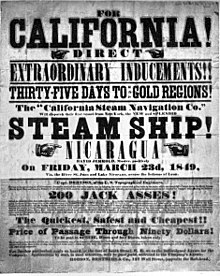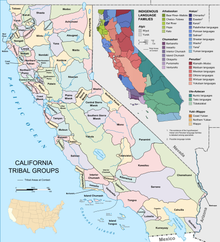California Gold Rush - Simple English Wikipedia, the free encyclopedia
This article does not have any sources. (June 2020) |
During the California Gold Rush, around 300,000[1] people traveled to California after gold was found at Sutter's Sawmill. The Gold Rush lasted from 1848-1855, peaking in 1952.[1]
While around $2 billion in gold was found during the Gold Rush, very few gold miners got rich.[1]
The Gold Rush had major effects on California's history, economy, and population. It may have helped the California Republic become a state in 1850.[1] People came from all over the world to look for gold. California's population boomed, and San Francisco became one of America's major cities.
Beginnings and growth
[change | change source]
Before gold was discovered in 1848, the California Republic's population was around 160,000; most of these people were Native Americans.[1] The Republic became a state in 1850, and by about 1855, more than 300,000 people had arrived in California.[1] (However, the Gold Rush happened at the same time as a genocide of indigenous people in California, and the Native American population declined drastically.[2][3])
In early 1848, a carpenter named James Wilson Marshall found small flakes of gold in a river while building a water-powered sawmill for John Sutter.[4] He immediately went to tell Sutter, and they tried to keep the gold a secret.[5] But word soon got out, and thousands of people started rushing west to look for gold. People who arrived in 1849 were nicknamed "forty-niners."
Over the next few years, hundreds of thousands of people traveled to California to seek their fortunes:[1]
- By August 1848, just a few months after gold was found at Sutter's Sawmill, there were 4,000 gold miners in California.
- By August 1849, there were around 80,000.
- By 1853, there were around 250,000.
People and jobs
[change | change source]
Some of the gold miners (also called "prospectors") found large amounts of gold and became wealthy, but most did not.
Not everyone who went to California during the Gold Rush looked for gold. Some opened businesses to provide services to gold miners (like clothing stores, barber shops, bakeries, and launderers).[6] A few got rich and powerful this way, like Levi Strauss, who invented jeans made of strong denim.[7]
Usually merchants, farmers, and other people who sold supplies earned more than gold miners. Sometimes a woman could earn more than her gold-mining husband.
Effects
[change | change source]The Gold Rush had a major impact on California's history, economy, and population. California was not a state when the Gold Rush began, and the Gold Rush may have helped it become a state in 1850.[1]

Before gold was discovered in 1848, the California territory's population was around 160,000; most of these people were Native Americans. By about 1855, more than 300,000 people had arrived. However, from 1851-1853, around one in every five people who arrived in California died within the next six months.[8]
California's population grew very rapidly. Between 1847 and 1860, California's population tripled.[9] Meanwhile, San Francisco became a major American city[8]. When the Gold Rush started, around 1,000 people lived there. Within two years, its population increased by 2,400%, and it had 25,000 full-time residents.[10]
This was also a time when many people immigrated to the United States. For example, of 67,000 people who came to California in 1852, 4 in every 10 (20,000 people) came from China.[9] They mined, built railroads, and worked on farms.[9]
The California genocide
[change | change source]The Gold Rush happened during the California genocide of indigenous people and made it worse.[2]

The genocide happened during the 19th century. During this time, government agents and private militias killed thousands of indigenous people in California (between 9,492 and 16,094 people, according to historians).[2] White settlers also kidnapped between 10,000[11] and 27,000[12] natives for forced labor. Hundreds to thousands of natives starved or were worked to death.[2]
The indigenous population also decreased dramatically because of disease, low birth rates, and starvation. Indigenous Californians were often raped and/or separated from their children. The state of California used its institutions (like its state legislature and court systems) to take away native people's land by favoring white settlers' rights over theirs.[2]
State authorities and private militias encouraged, tolerated, and committed these acts.[10][2][3]
Since the 2000s, most American academics and many activist organizations have used the word "genocide" to refer to this period of time.[2][13] In 2019, California's governor Gavin Newsom stated:
"It's called genocide. That's what it was, a genocide. No other way to describe it. And that's the way it needs to be described in the history books. And so I'm here to say the following: I'm sorry on behalf of the state of California [for the] violence, discrimination and exploitation [approved] by [the] state government throughout its history".[3]
In a 2019 Executive Order, Newsom formed the Truth and Healing Council to better understand the topic and inform future generations.[14]
Ending
[change | change source]As the Gold Rush went on, gold became harder and harder to find. Many of the forty-niners returned to their home countries, or gave up mining gold and found other work in California.
The California Gold Rush ended in 1855.
Related pages
[change | change source]References
[change | change source]- ↑ 1.0 1.1 1.2 1.3 1.4 1.5 1.6 1.7 "California Gold Rush | Definition, History, & Facts | Britannica". Encyclopedia Britannica. 2024-09-11. Retrieved 2024-09-29.
- ↑ 2.0 2.1 2.2 2.3 2.4 2.5 2.6 Adhikari, Mohamed (2022). Destroying to replace: settler genocides of indigenous peoples. Critical themes in world history. Indianapolis, Indiana: Hackett Publishing Company, Inc. ISBN 978-1-64792-054-8.
- ↑ 3.0 3.1 3.2 Favre, Lauren (July 19, 2019). "Newsom Apologizes to Native Americans for California's 'Dark History'". U.S. News and World Report. Retrieved September 29, 2024.
- ↑ "Eyewitness to the Discovery of Gold at Sutter's Mill - 1848". The Museum of the City of San Francisco. Retrieved 2024-10-01.
- ↑ "Sutter's Mill | California, United States | Britannica". Encyclopedia Britannica. Retrieved 2024-10-01.
- ↑ "California Gold Rush: A Significant Service (Lesson Plan)" (PDF). Autry Museum of the American West.
- ↑ "About Us - Levi Strauss History | Levi's® US". www.levi.com. Retrieved 2024-10-01.
- ↑ 8.0 8.1 "1868-1898 - Prelude: The California Gold Rush - A History of UCSF". history.library.ucsf.edu. Retrieved 2024-09-29.
- ↑ 9.0 9.1 9.2 "From Gold Rush to Golden State | Early California History: An Overview | Articles and Essays | California as I Saw It: First-Person Narratives of California's Early Years, 1849-1900 | Digital Collections | Library of Congress". Library of Congress, Washington, D.C. 20540 USA. Retrieved 2024-10-01.
- ↑ 10.0 10.1 Holliday, J. S. (1999). Rush for riches: gold fever and the making of California. [Oakland, Calif.] : Berkeley: Oakland Museum of California ; University of California Press. ISBN 978-0-520-21401-9.
- ↑ Pritzker, Barry (2000). A Native American Encyclopedia: History, Culture, and Peoples. Oxford University Press. p. 114.
- ↑ "NorCal Native Writes Of California Genocide | Jefferson Public Radio". The Jefferson Exchange. Archived from the original on 2019-11-14. Retrieved 2024-09-29.
- ↑ Wee, Eliza (2018-06-28). "Indian Boarding Schools: The Hidden History of Slavery in California". ACLU of Northern California. Retrieved 2024-09-29.
- ↑ "California Truth & Healing Council | The Governor's Office of Tribal Affairs". tribalaffairs.ca.gov. Retrieved 2024-09-29.


 French
French Deutsch
Deutsch